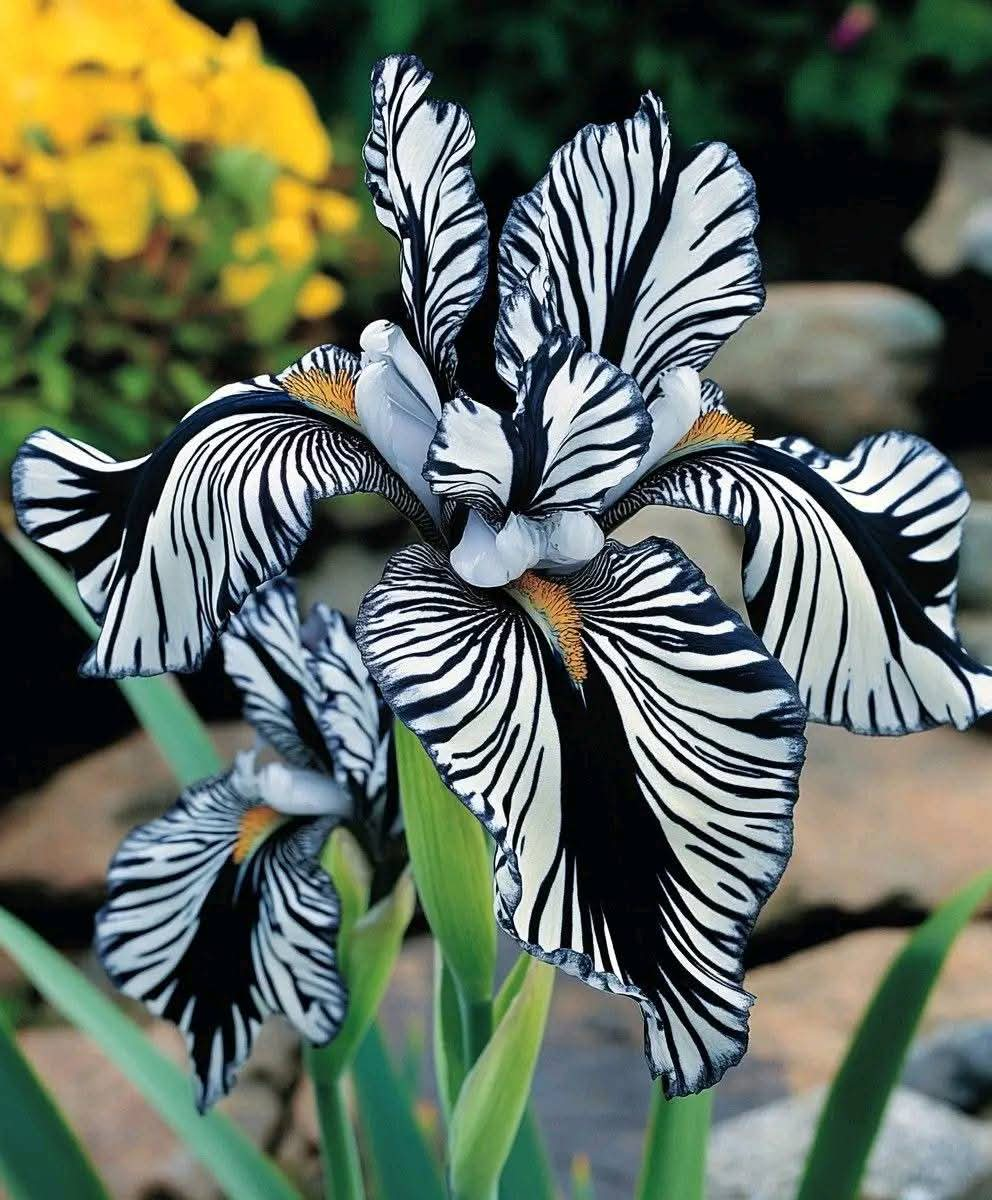If you’re looking to add a bold, artistic flair to your garden, the Zebra Stripes Iris (Iris germanica) is a must-have. With its dramatic striped petals and graceful silhouette, this iris variety turns heads and adds a touch of wild elegance to any landscape. Whether you’re a seasoned gardener or just starting your floral journey, the Zebra Stripes Iris is a low-maintenance beauty that rewards you with breathtaking blooms year after year.
Let’s explore everything you need to know about this captivating flower — from care tips to design ideas — so you can cultivate a garden centerpiece that truly stands out!
Why Choose Zebra Stripes Iris?
The Zebra Stripes Iris is not your average bloom. Its unique petals, adorned with striking streaks and contrasting hues, resemble brushstrokes on a canvas. This makes the plant an artistic masterpiece in itself, bringing texture and dimension to garden beds or serving as a dazzling standalone accent.
Key Features:
Distinctive Striped Petals: Eye-catching patterns that create visual intrigue.
Tall, Elegant Form: Gracefully rising above surrounding plants, adding height to the landscape.
Hardy & Resilient: Tolerates various conditions and returns reliably every year.
Pollinator-Friendly: Attracts bees and butterflies, adding life to your garden.
Whether you’re designing a cottage garden, a modern landscape, or a vibrant flower border, this iris variety effortlessly enhances any aesthetic.
Ideal Growing Conditions
Understanding the Zebra Stripes Iris’s needs will help you cultivate the healthiest, most vibrant blooms possible.
Light:
Full Sun: Irises thrive in at least 6 hours of direct sunlight daily. Ample sunlight encourages abundant flowering and prevents floppy stems.
Partial Shade Tolerance: While they prefer full sun, they can tolerate light shade, though blooms may be less prolific.
Water:
Moderate Watering: These irises prefer consistent moisture but dislike soggy soil. Water deeply once a week, allowing the soil to dry slightly between waterings.
Drought-Tolerant Once Established: After the plant is well-rooted, it can handle brief dry periods, making it suitable for low-maintenance landscapes.
Soil:
Well-Draining, Fertile Soil: Irises are prone to rot in waterlogged conditions, so use loamy or sandy soil enriched with organic matter for optimal growth.
pH Preference: They do well in slightly acidic to neutral soil (pH 6.5–7.0).
Temperature & Climate:
Thrives in Temperate Climates: The Zebra Stripes Iris flourishes in USDA zones 3–9, handling both cool winters and warm summers.
Winter Hardiness: The rhizomes can survive frost, but adding a layer of mulch in fall helps protect them from extreme cold.
Fertilizer:
Balanced Feeding: Apply a balanced fertilizer (10-10-10) in early spring, as new growth appears. Avoid high-nitrogen formulas, as they can promote excessive foliage at the expense of blooms.
With the right care, your irises will reward you with vibrant flowers that return stronger and more abundant each year!
Planting & Propagation
Planting Zebra Stripes Iris is simple, and once established, they’ll grace your garden for years with minimal effort.
When to Plant:
Late Summer to Early Fall (July–September): Planting during this window allows the rhizomes to establish roots before winter dormancy, ensuring vigorous spring growth.
How to Plant:
Prepare the Soil: Loosen the soil and mix in compost or well-rotted manure for added nutrients.
Dig a Shallow Hole: Create a hole wide enough for the rhizome, about 2–3 inches deep.
Position the Rhizome: Place the rhizome horizontally, with roots facing downward. Ensure the top of the rhizome is slightly exposed — burying it too deeply can hinder flowering.
Space the Plants: Leave 12–18 inches of space between each plant to allow for airflow and prevent overcrowding.
Water Thoroughly: Give the newly planted irises a good soak to help the roots settle in.
Propagation:
Division (Every 3–4 Years): Divide the rhizomes in late summer to prevent overcrowding and encourage vigorous blooming. Use a sharp knife to separate healthy sections, and replant them as described above.
Ongoing Care & Maintenance
Deadheading Spent Blooms: Remove faded flowers to encourage continuous blooming and prevent seed formation, which drains energy from the plant.
Pruning Foliage: After flowering, allow the leaves to remain until they yellow and die back naturally. This allows the plant to store energy for next year’s blooms.
Pest & Disease Control: Watch for iris borers, aphids, and snails. Treat infestations early with insecticidal soap or neem oil. Prevent fungal issues by ensuring good drainage and avoiding overhead watering.
With a little seasonal upkeep, your Zebra Stripes Iris will stay healthy and radiant for years to come!
Design Ideas & Companion Plants
The dramatic flair of the Zebra Stripes Iris makes it an excellent choice for various garden styles:
Focal Points: Plant in clusters to create a bold, eye-catching display.
Border Plantings: Line pathways or garden edges with irises for height and color.
Water Features: Their graceful stems look stunning near ponds or garden fountains.
Companion Plants:
Salvia: For contrasting spiky blooms.
Peonies: To complement the iris’s bold petals.
Daylilies: For staggered bloom times, extending the color season.
Lavender: To add fragrance and attract pollinators.
Pairing irises with plants that have varied bloom times ensures your garden stays vibrant from spring through late summer!
A Garden Gem Worth Growing
The Zebra Stripes Iris is more than just a flower — it’s a living piece of art. Its bold, striped petals and easy-going nature make it a standout addition to any garden. Whether you plant them as a dramatic focal point or weave them into a lush, layered landscape, these irises bring charm, elegance, and a touch of the unexpected.
With minimal care requirements and the ability to return year after year, the Zebra Stripes Iris is a perfect choice for gardeners of all levels. So why not add a little striped magic to your outdoor space? Your garden will thank you — and so will all the pollinators that come to visit!
Would you like me to create a step-by-step printable care guide or add more companion planting suggestions? Let me know — I’m here to help you create a garden you love!
More Articles You Might Like
-
Texas Toast Sloppy Joes: The Crunchy, Cheesy Upgrade You Didn’t Know You Needed
There’s something timeless about sloppy joes. For generations, this saucy, savory, and slightly sweet ground beef sandwich has been a go-to comfort food in American kitchens. It’s quick, filling, and family-friendly—perfect for busy weeknights. But what if we told you there’s a way to take this classic dish up a notch? Enter the Texas Toast…
-
Classic Pig Pickin’ Cake
When it comes to Southern desserts, few sweets shine as brightly as the Classic Pig Pickin’ Cake. This nostalgic cake, sometimes called a “Mandarin Orange Cake,” has roots deep in Southern tradition. It gets its playful name from its frequent appearance at pig pickin’s—Southern-style barbecue gatherings where communities come together to enjoy slow-cooked pork, sides,…
-
Lemon Garlic Butter Chicken with Creamy Parmesan Pasta
There’s something irresistible about the combination of tender, golden-browned chicken paired with a creamy pasta coated in Parmesan cheese. Add the brightness of lemon, the depth of garlic, and the richness of butter, and you have a recipe that feels indulgent yet approachable enough for a weeknight dinner. Lemon Garlic Butter Chicken with Creamy Parmesan…



